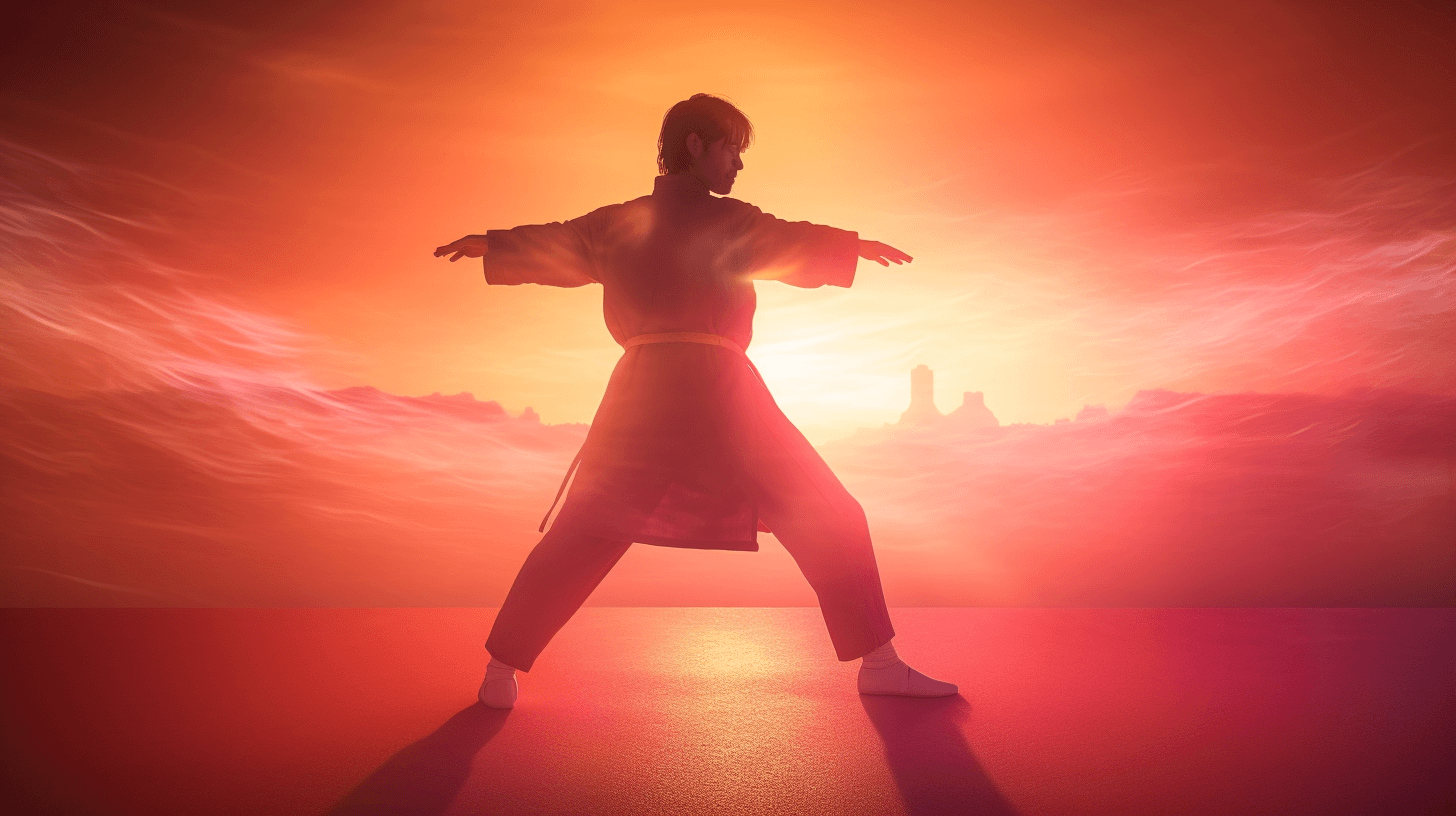😮🤸♀️💪 Tai Chi, Foa Yo Brain An’ Body: Get Started Wit’ Dis Mind-Blowin’ Workout!
“Parting da Wild Horse’s Mane.” “Wave Hands Like Clouds.” “Embrace Tiger, Return to Mountain.” No, dis ain’t some kine songs or poems, brah. Dem be da mind-bogglin’ moves of tai chi. 🐎☁️🐯⛰️
Wit’ ’bout 250 million peeps doin’ dis stuff all ova da world, tai chi stay one of da most popular physical activities out dea. Dis kine ting started in China back in da 17th century as one martial art. No like karate o’ taekwondo, tai chi focus on quiet strength, not scrap, so it stay mo’ accessible to older folks o’ da ones who wen’ get injured. 💃🌍
Shirley Chock, she 48 years old, started doin’ dis in her 20s afta she wen’ rip her A.C.L. Befo’ dat, she wen’ train in wushu kung fu, one kine mo’ acrobatic martial art dat wen’ make her rip up, but tai chi, it wen’ give her one low-impact way fo’ rehab. Dis fo’ma financial pro, she wen’ born in New York but wen’ grow up in Taiwan, wen’ find tai chi one big help fo’ deal wit’ stress an’ conflicts too. Afta ’bout two years, she wen’ start teachin’, an’ latah she wen’ take ova Aiping Tai Chi, one school in Connecticut where she wen’ train. Evah since den, “da most common ting I wen’ hear from older students is, ‘If only I wen’ find dis practice wen’ I was youngah,'” Ms. Chock wen’ say. So, dis why tai chi so useful, an’ I goin’ show you how fo’ start wen’ you ready. 🕺🏽🌟🙌
Why you gotta do tai chi, brah? Dis kine exercise, it mix up da mind focus wit’ da physical effort fo’ build up yo’ strength, flexibility, an’ mindfulness, say Dr. Peter Wayne, da head honcho of da Osher Center fo’ Integrative Medicine an’ da guy who wen’ write “Da Harvard Medical School Guide to Tai Chi.” 🧠💪🧘♀️
Da poses stay straight up an’ no as demandin’ as plenny yoga poses. “Cuz tai chi wen’ evolve fo’ physical function an’ interaction, I tink it translate bettah to everyday livin’ activities, like haulin’ groceries, openin’ doors o’ catchin’ stuff wen’ fall,” Dr. Wayne wen’ say. Tai chi stay different from passive kine techniques like meditashun, cuz you gotta do deep breathin’ an’ movement at da same time, an’ da experts say dat help calm yo’ nervous system, brah. 😌🏋️♀️🚪
Plenny research show dat tai chi can help wit’ balance an’ mobility, even fo’ folks wit’ neurological problems like Parkinson’s disease. An’ it help da oldah folks fo’ not fall down. Da oddah good ting bout tai chi, wen’ say Dr. Amanda Sammut, she da top doc fo’ rheumatology at Harlem Hospital an’ one assistant clinical professor of medicine at Columbia University, it make yo’ muscles strongah an’ take some strain off yo’ joints too, so you no goin’ feel all broke up. Dis why dey tell peeps wit’ knee an’ hip osteoarthritis fo’ do tai chi. An’ get dis, if you do dis regularly, two to three times a week, you might even notice improvements in yo’ mood, brah! Studies say it can help wit’ depression, anxiety, an’ yo’ overall well-bein’. 🏞️🌈🌻
Depending on yo’ fitness level, tai chi can be as aerobically challengin’ as one brisk walk fo’ da same amount of time. Dis practice no come wit’ plenny risks, but still, bettah check wit’ yo’ doc if you get chronic health issues, yeah? Gotta make sure you safe an’ sound. 🚶♀️🚑🆘
How you goin’ get started wit’ dis tai chi ting, brah? Da name tai chi, it mean both da physical practice an’ da underlying philosophy of yin an’ yang—dat everyting gotta have balance, yeah? No can have good without bad, no can have dark without light, Ms. Chock wen’ say. 🌓⚖️🧘♂️
Deya stay few different styles—like Yang, Chen, an’ Sun—dat get named aftah important teachahs o’ founders. “Even though get some differences, get way mo’ similarities,” Dr. Wayne wen’ say. No scientific evidence sayin’ one style bettah den da oddah. Fo’ beginners, Ms. Chock say you bettah go wit’ da Yang style. Dat one da most popula’, so plenny classes fo’ you pick from, brah. 🕺🎭👥
No get one standardized certification fo’ instructors, so Dr. Wayne say you bettah go online an’ search fo’ schools an’ classes. If you like understand da philosophy, find da ones who wen’ study ’em real deep, not just classes focusin’ on fitness. You gotta visit at least two classes fo’ make sure you feel good wit’ da space, how dey teach, an’ yo’ classmates. “Tai chi stay experiential; you gotta go an’ try ’em an’ feel ’em,” Ms. Chock wen’ say. 🌐🧐🏫
Some schools, dey charge plenny money—maybe $25 o’ mo’ fo’ one class. But oddahs get lowah fees o’ sliding-scale payments, an’ you might even find free classes through park districts o’ community organizations. You can even learn online, an’ some instructors who also healthcare providers, dey get virtual courses fo’ peeps wit’ arthritis an’ oddah health conditions, say Dr. Sammut. 🤑🖥️🩺
Da beginner classes, dey teach you da basics slow an’ steady, so you no goin’ feel all overwhelmed wit’ complicated steps. Dey start wit’ foundational exercises, gradually introduce concepts an’ principles, an’ den move on to simple choreography. Dis way, you can ease into it an’ not feel too stressed out. An’ it help if you know da names of da tai chi movements (dey usually refer to Chinese literature) as visual tools. Fo’ example, if you doin’ “Da White Crane Spreads Its Wings,” you can actually imagine one crane spreadin’ its wings, brah. 🤲🕊️
Even dough tai chi got one martial arts background, you probably no goin’ fight nobody. Da advanced students might spar wit’ each oddah, but most classes focus on individual movements. So, hea four moves perfect fo’ beginners, yeah? Check ’em out. 💃🥋
- Qi Pourin’ Stand wit’ yo’ feet shoulder-width apart. Bend yo’ knees gently, pick up yo’ left foot, an’ take one big step to da left. Shift yo’ body weight to da center. Start rockin’ back an’ forth, liftin’ yo’ heels, den yo’ toes, den yo’ heels again.
Every time you come forward onto yo’ toes, bring yo’ arms up to chest height, palms down, wrists relaxed. When you rock back on yo’ heels, bring yo’ arms back down to yo’ sides, palms facin’ back.
- Raisin’ da Powah Stand wit’ yo’ feet shoulder-width apart, den pick up yo’ left foot, an’ take one big step to da left. Bend yo’ knees a lil’ bit, like you goin’ into one mini-squat, while raisin’ yo’ arms up in front of you, keepin’ yo’ wrists an’ hands loose. Den press yo’ hands back down as you gradually straighten yo’ legs.
- Wave Hands Like Clouds Stand wit’ yo’ feet shoulder-width apart, gently bend yo’ knees as you pick up yo’ left foot, an’ take one big step to da left. Straighten yo’ knees, an’ as you do, lift yo’ arms to chest height, palms facin’ down, hands an’ wrists relaxed. Calmly bend yo’ knees back down into one mini-squat, arms in front of you. Turn yo’ waist so yo’ stomach an’ chest face right. While doin’ dat, shift yo’ weight onto yo’ right leg, brush yo’ right hand up an’ across in front of yo’ face, palm facin’ inward. Once yo’ hand crosses yo’ midline, lower yo’ arm back down.
Repeat da same move in da oddah direction, turn yo’ torso to da left, shift yo’ weight onto yo’ left leg, an’ brush yo’ left hand up an’ in front of yo’ face an’ den back down.
- Washin’ Yo’self Wit’ Qi From da Heavens Stand wit’ yo’ feet shoulder-width apart, lift yo’ left foot to take one big step to da side. Slowly lift yo’ arms up to yo’ sides an’ den overhead. Circle yo’ hands, palms down, in front of yo’ face an’ toward da floor. Picture rejuvenatin’ energy flowin’ through yo’ body, groundin’ you to da earth. 🌌✨🚿
So, brah, if you lookin’ fo’ one exercise dat work yo’ body an’ yo’ mind, tai chi stay da way to go. Plenty benefits fo’ all kine people, young an’ old. No mattah where you stay or what yo’ fitness level, you can get started wit’ dis incredible practice. Get out dea, find one class, an’ give tai chi one whirl. You nevah know, you might find one whole new world openin’ up fo’ you, bringin’ peace an’ strength to yo’ life. 🌏🧠💪
NOW IN ENGLISH
Tai Chi, For Your Brain and Body: Get Started With This Mind-Blowing Workout! 😮🤸♀️💪
“Parting the Wild Horse’s Mane.” “Wave Hands Like Clouds.” “Embrace Tiger, Return to Mountain.” No, this isn’t some kind of songs or poems, my friend. Those are the mind-boggling moves of Tai Chi. 🐎☁️🐯⛰️
With about 250 million people practicing this all over the world, Tai Chi is one of the most popular physical activities out there. This practice originated in China in the 17th century as a martial art. Unlike karate or taekwondo, Tai Chi focuses on quiet strength rather than combat, making it more accessible to older individuals or those prone to injuries. 💃🌍
Shirley Chock, a 48-year-old practitioner, started doing Tai Chi in her 20s after injuring her ACL. Prior to that, she trained in Wushu Kung Fu, a more acrobatic martial art that caused injuries. Tai Chi provided her with a low-impact way to rehabilitate herself. As a financial professional born in New York but raised in Taiwan, she found Tai Chi to be a great help in dealing with stress and conflicts as well. After about two years, she began teaching and later took over Aiping Tai Chi, a school in Connecticut where she trained. “The most common thing I hear from older students is, ‘If only I had found this practice when I was younger,'” says Ms. Chock. This is why Tai Chi is so useful, and I’ll show you how to get started when you’re ready. 🕺🏽🌟🙌
Why should you do Tai Chi? This exercise combines mental focus with physical effort to build your strength, flexibility, and mindfulness, according to Dr. Peter Wayne, the head of the Osher Center for Integrative Medicine and the author of “The Harvard Medical School Guide to Tai Chi.” 🧠💪🧘♀️
The poses in Tai Chi are upright and not as demanding as many yoga poses. “Since Tai Chi evolved for physical function and interaction, I think it translates better to everyday activities like carrying groceries, opening doors, or catching things that fall,” says Dr. Wayne. Tai Chi is different from passive techniques like meditation because it combines deep breathing and movement, which helps calm your nervous system. 😌🏋️♀️🚪
Numerous studies show that Tai Chi can help with balance and mobility, even for people with neurological conditions like Parkinson’s disease. It also helps older individuals avoid falling. Another benefit of Tai Chi, according to Dr. Amanda Sammut, the top rheumatology doctor at Harlem Hospital and an assistant clinical professor of medicine at Columbia University, is that it strengthens your muscles and reduces strain on your joints, which can alleviate discomfort. That’s why it’s recommended for people with knee and hip osteoarthritis. And guess what? If you do it regularly, two to three times a week, you might even notice improvements in your mood! Studies suggest that it can help with depression, anxiety, and overall well-being. 🏞️🌈🌻
Depending on your fitness level, Tai Chi can be as aerobically challenging as a brisk walk for the same amount of time. This practice comes with few risks, but it’s still a good idea to check with your doctor if you have chronic health issues. Safety first, my friend. 🚶♀️🚑🆘
So, how do you get started with Tai Chi? The name “Tai Chi” refers to both the physical practice and the underlying philosophy of yin and yang, the concept of balance in everything. “You can’t have good without bad, light without dark,” says Ms. Chock. 🌓⚖️🧘♂️
There are a few different styles, such as Yang, Chen, and Sun, named after important teachers or founders. “Although there are some differences, there are far more similarities,” says Dr. Wayne. There is no scientific evidence suggesting that one style is better than the others. For beginners, Ms. Chock recommends starting with the Yang style, as it is the most popular and offers plenty of class options. 🕺🎭👥
There is no standardized certification for Tai Chi instructors, so Dr. Wayne suggests going online and searching for schools and classes. If you want to understand the philosophy, look for instructors who have deep knowledge, not just classes focused on fitness. It’s a good idea to visit at least two classes to ensure that you feel comfortable with the space, teaching style, and your fellow classmates. “Tai Chi is experiential; you have to go and try it and feel it,” says Ms. Chock. 🌐🧐🏫
Some schools may charge a significant amount, perhaps $25 or more per class. However, others have lower fees or offer sliding-scale payments, and you might even find free classes through park districts or community organizations. You can also learn online, and some instructors who are also healthcare providers offer virtual courses for people with arthritis and other health conditions, according to Dr. Sammut. 🤑🖥️🩺
Beginner classes typically start by teaching you the basics slowly and steadily, so you won’t feel overwhelmed by complicated steps. They begin with foundational exercises, gradually introduce concepts and principles, and then move on to simple choreography. This way, you can ease into it and not feel too stressed out. Knowing the names of the Tai Chi movements (usually referring to Chinese literature) can be helpful as visual cues. For example, when doing “The White Crane Spreads Its Wings,” you can imagine a crane spreading its wings. 🤲🕊️
Even though Tai Chi has martial arts roots, you probably won’t be fighting anyone. Advanced students might spar with each other, but most classes focus on individual movements. So, here are four beginner-friendly moves for you to try. 💃🥋
- Qi Pouring
- Stand with your feet shoulder-width apart.
- Gently bend your knees, lift your left foot, and take a big step to the left.
- Shift your body weight to the center and start rocking back and forth, lifting your heels, then your toes, and then your heels again.
- Each time you come forward onto your toes, bring your arms up to chest height with palms down and relaxed wrists.
- When you rock back onto your heels, bring your arms back down to your sides with palms facing back.
- Raising the Power
- Stand with your feet shoulder-width apart.
- Lift your left foot and take a big step to the left.
- Bend your knees slightly, like going into a mini-squat, while raising your arms up in front of you with loose wrists and hands.
- Gradually press your hands back down as you straighten your legs.
- Wave Hands Like Clouds
- Stand with your feet shoulder-width apart and gently bend your knees.
- Lift your left foot and take a big step to the left.
- Straighten your knees while lifting your arms to chest height with palms facing down and relaxed hands and wrists.
- Bend your knees back down into a mini-squat, keeping your arms in front of you.
- Turn your waist so that your stomach and chest face right.
- While doing that, shift your weight onto your right leg and brush your right hand up and across in front of your face with the palm facing inward.
- Lower your arm back down once it crosses your midline.
- Washing Yourself with Qi From the Heavens
- Stand with your feet shoulder-width apart and lift your left foot to take a big step to the side.
- Slowly lift your arms up to your sides and then overhead.
- Circle your hands, palms down, in front of your face and toward the floor.
- Visualize rejuvenating energy flowing through your body, grounding you to the earth. 🌌✨🚿
So, if you’re looking for an exercise that works your body and mind, Tai Chi is the way to go. It offers plenty of benefits for people of all ages and fitness levels. No matter where you are or what your fitness level is, you can get started with this incredible practice. Find a class and give Tai Chi a try. You never know, it might open up a whole new world of peace and strength in your life. 🌏🧠💪







